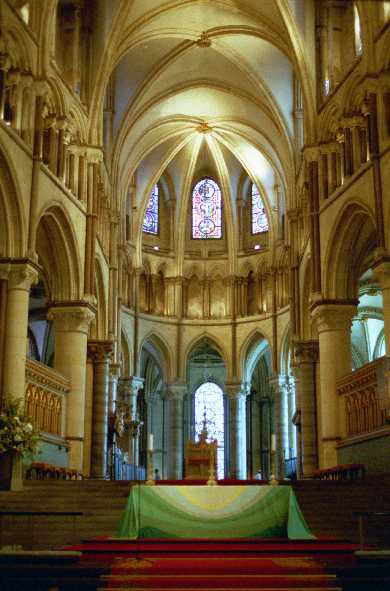
Thomas Becket, also known as Saint Thomas of Canterbury, Thomas of London and later Thomas à Becket, was Archbishop of Canterbury from 1162 until his murder in 1170. He is venerated as a saint and martyr by both the Catholic Church and the Anglican Communion. He engaged in conflict with Henry II, King of England, over the rights and privileges of the Church and was murdered by followers of the king in Canterbury Cathedral. Soon after his death, he was canonised by Pope Alexander III.

Canterbury Cathedral in Canterbury, Kent, is one of the oldest and most famous Christian structures in England. It forms part of a World Heritage Site. It is the cathedral of the Archbishop of Canterbury, currently Justin Welby, leader of the Church of England and symbolic leader of the worldwide Anglican Communion. Its formal title is the Cathedral and Metropolitical Church of Christ at Canterbury.

Hubert Walter was an influential royal adviser in the late twelfth and early thirteenth centuries in the positions of Chief Justiciar of England, Archbishop of Canterbury, and Lord Chancellor. As chancellor, Walter began the keeping of the Charter Roll, a record of all charters issued by the chancery. Walter was not noted for his holiness in life or learning, but historians have judged him one of the most outstanding government ministers in English history.
William de Corbeil or William of Corbeil was a medieval Archbishop of Canterbury. Very little is known of William's early life or his family, except that he was born at Corbeil, south of Paris, and that he had two brothers. Educated as a theologian, he taught briefly before serving the bishops of Durham and London as a clerk and subsequently becoming an Augustinian canon. William was elected to the See of Canterbury as a compromise candidate in 1123, the first canon to become an English archbishop. He succeeded Ralph d'Escures who had employed him as a chaplain.
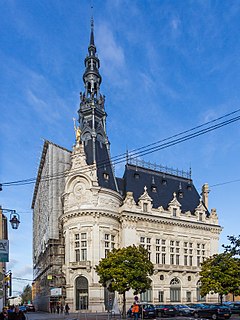
Sens is a commune in the Yonne department in Bourgogne-Franche-Comté in north-central France, 120 km from Paris.
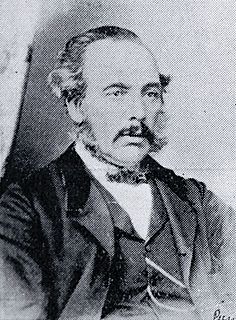
Isaac Luck was a New Zealand architect. A professional builder, he arrived in Lyttelton on the Steadfast in 1851. He was the third chairman of the Christchurch Town Council. He was the brother-in-law of and in partnership with Benjamin Mountfort, and was the less well-known architectural partner for the design of the Canterbury Provincial Council Buildings.
Henry Yevele was the most prolific and successful master mason active in late medieval England. The first document relating to him is dated 3 December 1353, when he purchased the freedom of London. In February 1356 he was sufficiently well known as a mason that he was chosen as one of a commission of six cutting masons who were to inform the mayor and aldermen about the acts and articles of the craft.

Thomas of Bayeux was Archbishop of York from 1070 until 1100. He was educated at Liège and became a royal chaplain to Duke William of Normandy, who later became King William I of England. After the Norman Conquest, the king nominated Thomas to succeed Ealdred as Archbishop of York. After Thomas' election, Lanfranc, Archbishop of Canterbury, demanded an oath from Thomas to obey him and any future Archbishops of Canterbury; this was part of Lanfranc's claim that Canterbury was the primary bishopric, and its holder the head of the English Church. Thomas countered that York had never made such an oath. As a result, Lanfranc refused to consecrate him. The King eventually persuaded Thomas to submit, but Thomas and Lanfranc continued to clash over ecclesiastical issues, including the primacy of Canterbury, which dioceses belonged to the province of York, and the question of how York's obedience to Canterbury would be expressed.
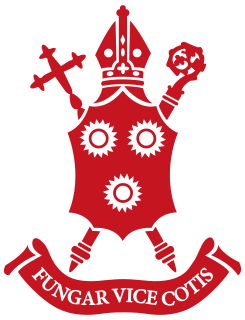
St Edmund's School, Canterbury is an independent day and boarding school located in Canterbury, Kent, England and established in 1749. The extensive school grounds were acquired in 1855. The school currently caters for girls and boys aged 3–18, including the Choristers of Canterbury Cathedral.

William of Sens or Guillaume de Sens was a 12th-century French master mason and architect, believed to have been born at Sens, France. He is known for rebuilding the choir of Canterbury Cathedral between 1174 and 1177, counted first important example of the Early Gothic Style of architecture in England, finished in 1184. Before Canterbury, he worked on Sens Cathedral. According to one English source, he died at Canterbury on 11 August 1180. According to other sources, he died in France, after returning from England.

The Corona, Canterbury Cathedral is the east end of Canterbury Cathedral, named after the severed crown of Thomas Becket, whose shrine it was built to contain.
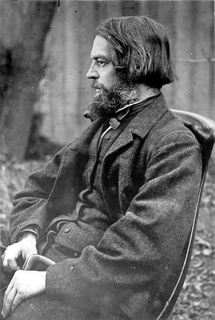
Benjamin Woolfield Mountfort was an English emigrant to New Zealand, where he became one of that country's most prominent 19th-century architects. He was instrumental in shaping the city of Christchurch's unique architectural identity and culture, and was appointed the first official Provincial Architect of the developing province of Canterbury. Heavily influenced by the Anglo-Catholic philosophy behind early Victorian architecture, he is credited with importing the Gothic revival style to New Zealand. His Gothic designs constructed in both wood and stone in the province are considered unique to New Zealand. Today, he is considered the founding architect of the province of Canterbury.

The Anglican Diocese of Ballarat extends across the south-west region of Victoria, Australia. It is one of the five Anglican Church of Australia dioceses in the ecclesiastical Province of Victoria.

William Walsh was a Prebendary of St Paul's Cathedral, Bishop of Mauritius and Dover. At the end of his life he was Archdeacon of Canterbury. While he was Bishop of Mauritius, the island experienced one of its worst cyclones; in consequence his cathedral had to be used temporarily as a hospital.

English Gothic is an architectural style which flourished in England from about 1180 until about 1520. The style was most prominently used in the construction of cathedrals and churches. Its defining features are pointed arches, rib vaults, buttresses, and an extensive use of stained glass. Combined, these features allowed the creation of buildings of unprecedented height and grandeur, filled with light from large stained glass windows. Important examples include Westminster Abbey, Canterbury Cathedral and Salisbury Cathedral. The English Gothic style endured in England until the early sixteenth century – much longer than in Continental Europe. It was succeeded by Tudor architecture and Renaissance architecture.

The medieval cathedrals of England, which date from between approximately 1040 and 1540, are a group of twenty-six buildings that constitute a major aspect of the country’s artistic heritage and are among the most significant material symbols of Christianity. Though diverse in style, they are united by a common function. As cathedrals, each of these buildings serves as central church for an administrative region and houses the throne of a bishop. Each cathedral also serves as a regional centre and a focus of regional pride and affection.
Events from the 1170s in England.
Events from the 1070s in England.

Hon. Hugh Percy was an Anglican bishop who served as Bishop of Rochester (1827) and Bishop of Carlisle (1827–56).
Sir William Whitfield was a British architect and town planner.
